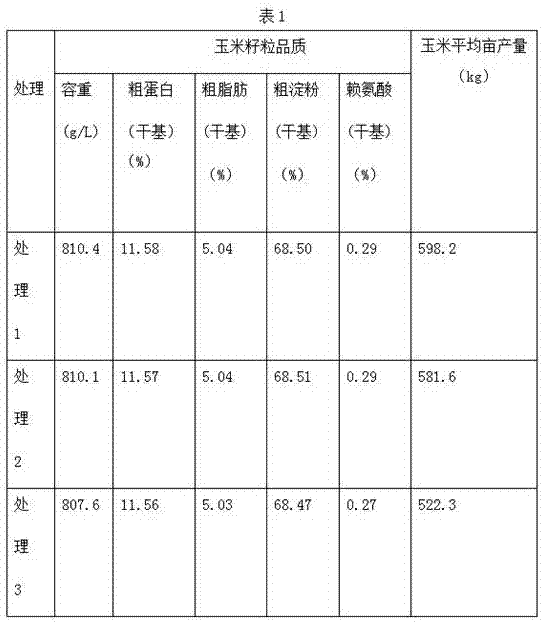Potassium polyphosphate slow-release fertilizer for corns, and production method of potassium polyphosphate slow-release fertilizer
A technology of potassium polyphosphate and slow-release fertilizer, applied in the direction of ammonium orthophosphate fertilizer, alkaline orthophosphate fertilizer, phosphate fertilizer, etc., can solve the problems of high product cost, high price of slow-release fertilizer, low corn yield, etc. The effect of convenient transportation and use, unique preparation method and high nutrient content
- Summary
- Abstract
- Description
- Claims
- Application Information
AI Technical Summary
Problems solved by technology
Method used
Image
Examples
Embodiment 1
[0032] A potassium polyphosphate slow-release fertilizer for corn, comprising the following raw materials in parts by weight:
[0033] 55 parts of urea; 45 parts of potassium polyphosphate; 10 parts of diammonium hydrogen phosphate; 0.5 parts of magnesium sulfate; 0.4 parts of calcium nitrate; 1.5 parts of trace elements; 8 parts of bone meal; 5 parts of humic acid; 4 parts; 10 parts of slow-release agent; described trace element and weight ratio are Fe:Mn:Zn:Cu:B:Mo=3:2:3:2:2:0.8.
[0034] The preparation method of described potassium polyphosphate comprises the following steps:
[0035] ① Put yellow phosphorus in a combustion furnace and burn it at 500°C to get P 2 o 5 gas;
[0036] ②Use a blower to blow P 2 o 5 The gas is pumped into the polymerization tower, and the water is continuously poured to make P 2 o 5 The gas dissolves in water, to the P in the solution 2 o 5 The weight concentration of reaches 72%, obtains solution;
[0037] 3. in the solution obtained...
Embodiment 2
[0045] A potassium polyphosphate slow-release fertilizer for corn, comprising the following raw materials in parts by weight:
[0046] 60 parts of urea; 48 parts of potassium polyphosphate; 12 parts of diammonium hydrogen phosphate; 0.6 parts of magnesium sulfate; 0.5 parts of calcium nitrate; 1.8 parts of trace elements; 9 parts of bone meal; 7 parts of humic acid; 5 parts; 12 parts of sustained-release agent; described trace element and weight ratio are Fe:Mn:Zn:Cu:B:Mo=3:2:3:2:2:0.8.
[0047] The preparation method of described potassium polyphosphate comprises the following steps:
[0048] ① Put yellow phosphorus in a combustion furnace and burn it at 600°C to get P 2 o 5 gas;
[0049] ②Use a blower to blow P 2 o 5 The gas is pumped into the polymerization tower, and the water is continuously poured to make P 2 o 5 The gas dissolves in water, to the P in the solution 2 o 5 The weight concentration of reaches 81%, obtains solution;
[0050] 3. in the solution obt...
Embodiment 3
[0058] A potassium polyphosphate slow-release fertilizer for corn, comprising the following raw materials in parts by weight:
[0059] 65 parts of urea; 50 parts of potassium polyphosphate; 15 parts of diammonium hydrogen phosphate; 0.8 parts of magnesium sulfate; 0.6 parts of calcium nitrate; 2.0 parts of trace elements; 10 parts of bone meal; 10 parts of humic acid; 6 parts; 15 parts of sustained-release agent; said trace elements and weight ratio are Fe:Mn:Zn:Cu:B:Mo=3:2:3:2:2:0.8.
[0060] Above-mentioned potassium polyphosphate corn slow-release fertilizer, the preparation method of described potassium polyphosphate comprises the following steps:
[0061] ① Put yellow phosphorus in a combustion furnace and burn it at 700°C to get P 2 o 5 gas;
[0062] ②Use a blower to blow P 2 o 5 The gas is pumped into the polymerization tower, and the water is continuously poured to make P 2 o 5 The gas dissolves in water, to the P in the solution 2 o 5 The weight concentratio...
PUM
 Login to View More
Login to View More Abstract
Description
Claims
Application Information
 Login to View More
Login to View More - R&D
- Intellectual Property
- Life Sciences
- Materials
- Tech Scout
- Unparalleled Data Quality
- Higher Quality Content
- 60% Fewer Hallucinations
Browse by: Latest US Patents, China's latest patents, Technical Efficacy Thesaurus, Application Domain, Technology Topic, Popular Technical Reports.
© 2025 PatSnap. All rights reserved.Legal|Privacy policy|Modern Slavery Act Transparency Statement|Sitemap|About US| Contact US: help@patsnap.com

